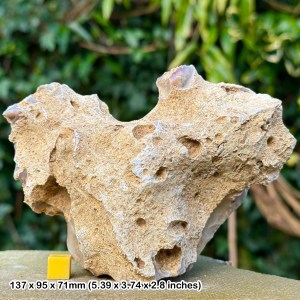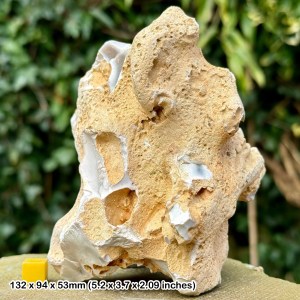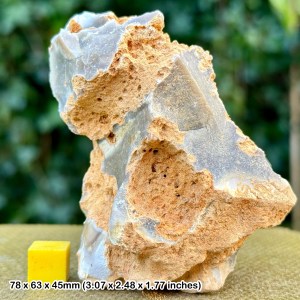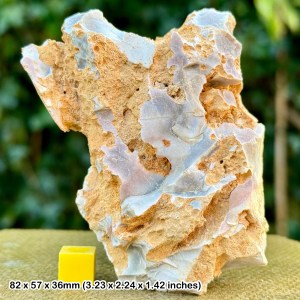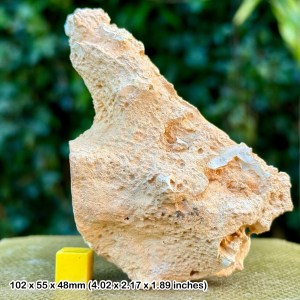Hooken Cliff is the best location in Devon for finding fossils, in particular, echinoids, ammonites, fish and brachiopods, which are easy to find – you just never know what you may find. They can be found in the White Chalk Subgroup (Seaton Formation) and the Grey Chalk Subgroup and in the Upper Greensand.
DIRECTIONS
♦ Hooken Cliff is also an important area for wildlife. It is a huge landslip, which is rich in fauna and flora. You can access this either by walking through the old landslide or from Branscombe. Branscombe is the best point of access. Drive down to the mouth of the small mill stream, where you will find a large car park.
♦ From here, walk east until you reach the cliffs at the edge of the landslide. You can also walk from Beer and down through the landslide. This has spectacular views, but is also a long walk and can be challenge for some.
♦ Ref: 50.68683°N, 3.11898°W
PROFILE INFO
FIND FREQUENCY: ♦♦♦♦♦ – The rocks at Hooken are very rich in fossils and you will be almost certain to come home with lots of finds. It is the most productive fossil location in Devon.
CHILDREN: ♦♦♦ – This site is suitable for families with older children, but children MUST keep away from the cliff edge. In addition, the walk may be too far for some younger children.
ACCESS: ♦♦♦ – The location is quite a walk, as it sits between Beer and Branscombe. If you are planning to visit this location by means of the landslide walk from Beer, then access would be rated as very poor – it is a long walk from the car park in this village.
TYPE: – Most fossils are found in the fallen blocks, which can be seen on the foreshore or at the bottom of the cliffs. Fossils such as echinoids can also be found loose in the scree slopes. Hooken is also an important site for the fauna and flora living and growing behind the old landslide, so you should respect this aspect of the site. The cliffs on the beach and the rocks on the foreshore are full of fossils and there are no restrictions on collecting here.
FOSSIL HUNTING
It is easy to find fossils at Hooken Cliff. The old landslide is constantly being eroded by the rain, wind and sea, and boulders of Chalk and Upper Greensand frequently fall onto the beach.
If you search through the boulders on the foreshore, these are usually full of fossils. The best blocks are those from the Grey Chalk Subgroup (previously Middle Chalk), with the fossils in this being superbly preserved and fairly easy to get out. The best blocks are those that have been sitting around for a while, as the harder fossils weather out of the softer chalk, making them easy to spot.
Keep an eye open for loose echinoids along the foreshore, which have been washed out of the chalk. However, they can be hard to spot. In addition, the Upper Greensand here is rich in fossil brachiopods, oysters and bivalves. Ammonites can also be found in this. In addition, other fossils such as sharks’ teeth, corals and sponges can be found here – you just never know what you might find.



GEOLOGY
The White Chalk Subgroup of the Seaton Chalk Formation (previously Middle Chalk) is of Cretaceous age of around 90 Mya) and makes up the uppermost beds at Hooken Cliff. It consists of the Terebratulina lata and the Inoceramus labiatus (Orbirhynchia cuvieri) Zones.
This chalk is the most fossiliferous of the rocks here, but it is only accessible from fallen blocks.
Most of the cliff at Hooken to Beer comprises of the Beer Limestone Formation of the Hooken Nodular Limestone Bed. This is from the Grey Chalk Subgroup (previously known as Lower Chalk. This is Upper Cretaceous in age from the Cenomanian stage, of 96 Mya.
In the lowest part of the cliff, Upper Greensand (Lower Cretaceous, Albian ~105 Mya) is present. This rock can also be seen on the foreshore during scouring conditions.


SAFETY
Common sense when collecting at all locations should always be used and knowledge of tide times is essential. The main danger at Hooken Cliff is from falling rocks. The cliffs are extremely tall and cliff falls are quite common. You should keep away from the base of the cliff at all times and wear a hard hat.
EQUIPMENT
Some of the rocks can be quite soft and a pick or knife is ideal for removing fossils from these. There is also harder chalk and greensand, for which a hammer is appropriate. A chisel is essential for getting any important finds out and safety goggles are a must.
ACCESS RIGHTS
This site is an SSSI. This means you can visit the site, but hammering the bedrock is not permitted. For full information about the reasons for the status of the site and restrictions please download the PDF from Natural England – SSSI Information – Hooken Cliff
It is important to follow our ‘Code of Conduct’ when collecting fossils or visiting any site. Please also read our ‘Terms and Conditions‘
LINKS
♦ Buy Fossils, Crystals, Tools
♦ Location Discussions
♦ Deposits Magazine
♦ Join Fossil Hunts
♦ UK Fossils Network
-
Fossil sponge in flint, grey chalk subgroup, cretaceous, branscome, devon, uk – genuine
£24.00 -
Fossil sponge in flint, grey chalk subgroup, cretaceous, branscome, devon, uk – genuine
£24.00 -
Fossil sponge in flint, grey chalk subgroup, cretaceous, branscome, devon, uk – genuine
£24.00 -
Fossil sponge in flint, grey chalk subgroup, cretaceous, branscome, devon, uk – genuine
£12.00 -
Fossil sponge in flint, grey chalk subgroup, cretaceous, branscome, devon, uk – genuine
£12.00 -
Fossil sponge in flint, grey chalk subgroup, cretaceous, branscome, devon, uk – genuine
£12.00 -
Fossil sponge in flint, grey chalk subgroup, cretaceous, branscome, devon, uk – genuine
£12.00 -
Fossil sponge in flint, grey chalk subgroup, cretaceous, branscome, devon, uk – genuine
£12.00 -
Fossil sponge in flint, grey chalk subgroup, cretaceous, branscome, devon, uk – genuine
£12.00


























